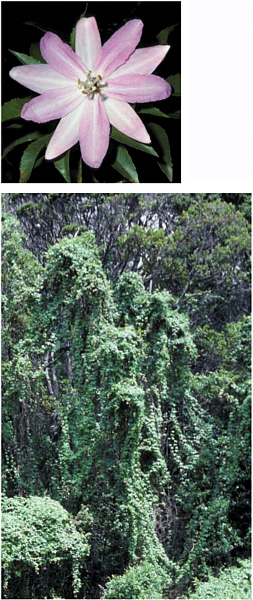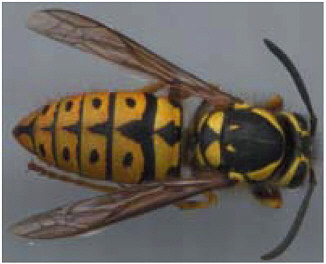Alien Species Pose a Severe Threat to Hawaii’s Native Plants and Animals
The colonization of the Hawaiian islands by humans has had a dramatic impact on the native plant and animal life of the archipelago. When the Polynesians arrived on the islands 1,200 to 1,600 years ago, they brought with them a number of plant and animal species, including taro, sugarcane, coconut palm, pigs, and chickens. The arrival of European colonizers over the past 200 years greatly accelerated the rate of introduction of alien species. Today almost as many non-native plants as native plants grow wild on the islands. Hundreds of alien species of insects, birds, mammals, and other animals have gained firm footholds. Some of these introductions were deliberate, as when crop plants, ornamental flowering plants, and non-native songbirds were brought to the islands (see Figure 16). Others were accidental, as when alien insects and animals traveled to Hawaii in cargo, ship holds, or even the wheel wells of airplanes.
Many introduced species have had little or no effect on the native flora and fauna of the Hawaiian islands. But the impact of some alien species has been devastating. Introduced goats, pigs, sheep, and cattle graze on native plants. Introduced birds, feral cats, mongooses, and avian malaria have been eliminating native birds. The Formosan ground termite now causes many millions of dollars of damage to structures in Hawaii each year. Yellowjackets (see Figure 17) introduced into the islands in a shipment of Christmas trees have been eliminating insect populations, which in turn reduces food supplies for native birds. Land clearing, agriculture, and urbanization have transformed lowland ecosystems. Since

Figure 16
The banana poka vine, introduced into Hawaii in the 1920s as an ornamental plant, has spread throughout Hawaii’s forests and fields, where it overgrows and smothers native plants. (Photographs courtesy of Gerald Carr.)
humans arrived in Hawaii, at least 10 percent of the native Hawaiian plants have gone extinct, and an additional 40 to 50 percent are threatened or endangered.
Evolutionary theory helps explain why many native species have been so vulnerable to invaders in Hawaii. Before humans began introducing non-native animals and plants in great numbers, fewer natural predators lived in Hawaii than on the mainland. As a result, many native species gradually lost preexisting defenses, such as thorns or toxins, because variants without the defenses might have enjoyed one or more adaptive advantages. (For example, they might have been able to use for other purposes the metabolic energy that would have been expended to build defenses that were not needed in the environment of Hawaii.) Many native Hawaiian species also developed adaptations allowing them to move into ecological niches that they could not have occupied on the mainland. When alien species were introduced into the islands, they had competitive advantages that many native species did not.
An understanding of evolution is essential when anticipating and mitigating the possible effects of alien species on an ecosystem. The processes of evolution contribute to the

Figure 17
The spread of introduced yellowjackets in Hawaii since the early 1980s has decimated many native insect species. (Photograph courtesy of David Foote, Pacific Island Ecosystems Research Center, U.S. Geological Survey.)
assemblage of species in a given environment. The introduction of new species into that environment therefore will have consequences that reflect the evolutionary history of the ecosystem. By understanding the role of evolution in shaping an ecosystem, it may be possible to reduce the impact of introduced species. For example, modern ecosystem management techniques subject entire ecosystems to regular treatments, such as simulated natural fire regimes, that favor native species over introduced species.
Many Critical Problems Cannot Be Addressed Without Understanding Biological Evolution
Responding to the impact of introduced species, in Hawaii and elsewhere, is just one area where evolutionary theory can affect public policy. Many other examples can be cited. Many pathogenic microorganisms are evolving resistance to the drugs that have been used to control them, leading to outbreaks of disease. The AIDS virus changes its genetic makeup so quickly within its human hosts that the drugs that have been used to counter the virus gradually lose their effectiveness. Agricultural pests have evolved defenses against pesticides, and based on our understanding of evolution they will continue to do so.
The only way to counter these threats effectively is to anticipate the ability of populations of living things to change over time. For example, evolutionary theory points toward strategies that can greatly reduce the


